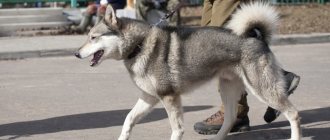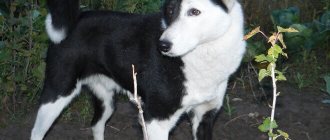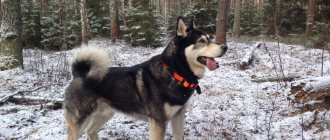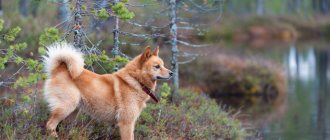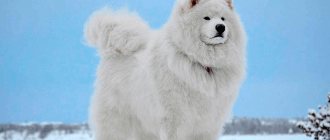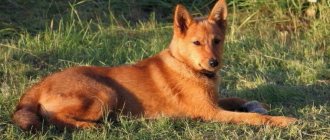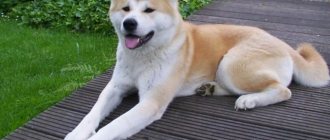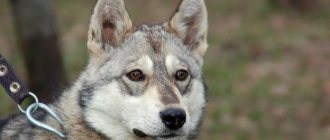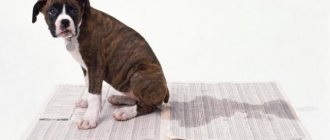History of the East Siberian Laika breed
Modern East Siberian Laikas are descendants of hunting dogs that were bred by the indigenous population of Siberia from ancient times.
The main occupation of the ancestors of the breed was hunting fur-bearing animals, since the fur trade in Russia has flourished since time immemorial and was considered a profitable craft. But since the population density beyond the Ural ridge was always small, the animals bred and lived in relative isolation. Ultimately, this led to the stratification of the husky clan into offspring that differed from each other in their working characteristics and external characteristics. The first attempt to describe hunting dogs was made at the end of the 19th century by researchers Shirinsky-Shakhmatov, Liverovsky and Krestnikov. After traveling through Siberia and Transbaikalia, breeders identified 20 types of aboriginal huskies, basing their descriptions on the geographical principle of breed distribution. As for a full-fledged classification, it was possible to create it only in 1949, when members of the Soviet society “Glavokhota” agreed to standardize animals. It was decided to distinguish four main breeds - Karelian-Finnish, Russian-European, East Siberian and West Siberian Laika. Moreover, only a temporary standard was written for East Siberian Laikas, since there was very little factual material about the exterior and working qualities of Orientals.
The breed owes its modern standard to the Soviet cynologist A.V. Geits. Over 13 years of work, the specialist has studied more than eight thousand East Siberian huskies and systematized their external characteristics. It was at his request that the growth limits of the breed were established, as well as the dog body elongation index. In addition, the area of origin of the AFL was narrowed. If earlier, in addition to Siberia, the Far East was also considered the homeland of animals, then after the research of A.V. Geits, the eastern outskirts of the country were excluded from this list. The final standard, which specified the specific colors of the breed, as well as the type of bone structure, was approved for Orientals in 1981. Breeders and exhibition commissions are still guided by it.
History of the breed
The homeland of the East Siberian Laika is the Soviet Union, namely the territory of the Far East and Siberia.
For the first time, this breed became known in the nineteenth century; it was during this period that the active development of the Eastern Siberian regions of Russia took place.
Vostochnosibirskaya-layka is listed in the group of the main varieties of husky. Until the beginning of the twentieth century, this group consisted of dozens of species, but then only four main ones were identified:
1. Russian-European. 2. Karelo-Finnish. 3. West Siberian. 4. East Siberian.
It is believed that all of these breeds have a single ancient ancestor - the wolf. The similarity with a wild predator can be seen in modern huskies not only in appearance, but in endurance and the ability to hunt.
Regarding the ancestors of the East Siberian Laika, there is an assumption that it originated from Amur and wild Evenki dogs. It is also assumed that genes from other husky species are present in the blood of VSL.
From its Amur ancestor, VSL inherited great speed, which is not surprising, because the Amur Laika was specially bred as a sled dog. The Evenki ancestors passed on to the VSL the ability to pursue the beast for a long time without rest and without food.
Irkutsk became the breeding center for Easten-Sibirian Laika. It was in this city that the first East Siberian Laika nursery was officially registered.
Russian breeders began closely breeding this breed in the second half of the twentieth century. The International Federation of Cynologists officially recognized the Vostochnosibirskaya Layka breed in 1980.
Despite many advantages, the East Siberian Laika is less popular compared to other varieties of Laika; its population throughout the world is very low. The largest number of these dogs live in Russia. Outside its homeland, the VSL is a rare species.
Breed standard East Siberian Laika
Initially, individuals with a strong type of constitution were considered exemplary. However, modern rules are more loyal to animals with lean muscles. Nevertheless, it is unacceptable to compare two dogs with polar types of condition in the ring. Sexual dimorphism is also inherent in Orientals: the height of a purebred male should be no less than 55 and no more than 64 cm, females should be from 51 to 60 cm.
For VSL workers, the body elongation index is important. In males it ranges from 104-109, in females it ranges from 107-112. It is not difficult to visually determine which dog is more suitable for fishing activities. To do this, it is enough to compare the height of the animal at the withers with the length of the body. If the second value exceeds the first, this is a good sign. Laikas with a stretched body, sufficient height and a strong constitution are more resilient and work easier in snowdrifts. At the same time, too large and too short individuals are considered an unenviable acquisition. The former are harder to climb and with age acquire a loose constitution, the latter quickly get tired and do not work well in heavy snow.
Head
When viewed from above, the skull has a wedge-shaped outline, resembling an equilateral triangle. The brow ridges of the breed are not pronounced, the stop is smooth, the forehead is almost flat. Puppies may have a bulge in the frontal area (growth plate), which levels out by 3-4 years.
As they grow older, the head of the East Siberian husky expands in width due to an increase in muscle mass. The dog's muzzle is rough, normally filled in the area under the eyes, bar-type. There are no signs of wet lips.
Jaws
The jaws are massive and wide with tightly closed incisors. The bite of the premolars is of the wolf type, that is, open. The grip of the jaws is deep and strong.
Eyes
The distinctive features of the eyes of the East Siberian Laika are the oblique cut of the eyelids, almond shape, moderate set (the eyeballs are not protruding, but are not “recessed” deep into the eye sockets). The iris is brown or dark brown, regardless of color.
Ears
The shape of the VSL ear resembles an isosceles triangle with a pointed or slightly rounded apex (ear tip). Standing almost at eye level, in addition, a slight collapse is noticeable when the back edges of the ears are not parallel to each other.
Neck
The necks of East Siberian huskies can be either round or slightly oval in cross-section. The position of the neck in relation to the body is at an angle of 40-50°. The length of the neck corresponds to the length of the head.
Frame
The East Siberian Laika is a strong and moderately pumped up pet. The stretched silhouette characteristic of the breed is ensured by a straight, wide back. In this case, the lumbar region should not be excessively long. The croup is wide, with a moderate slope in the rear. The bottom is tucked, with a slightly pronounced transition from the sternum to the abdomen.
The breed's chest is deep, strong, often falling a couple of centimeters below the elbows or reaching their level. The standard allows oval breasts in cross-section, but does not accept ovoid breasts. An important nuance: for fishing in snowy areas, dogs with an overly developed chest are not the best option, since when the front legs reach out, the wide sternum prevents the shoulder blades from turning outward.
Limbs
The straight and parallel front legs impress with their powerful bones and strength. The shoulders are moderately oblique, the angles of the glenohumeral joints are within 90-100°. The olecranon processes are pronounced, looking backward. The pasterns are short and have a slight slope.
Hind limbs without curvature, parallel to each other. The angles of the joints are clearly marked. The shins are noticeably longer than the thighs, the metatarsals are vertical. The oriental paws gather into a ball, resembling a circle or oval in outline. The presence of dewclaws on the hind legs is unacceptable.
Tail
Crescent-shaped or rolled into a ring-shaped structure. When straightened, the tip is at the level of the hock joints or 1-2 cm shorter.
Wool
The straight spine is characterized by a rigid, rough structure. The undercoat is silky but dense, performing the function of a natural sweatshirt. The hair on the ears and head is short and close. On the neck and shoulders the hair grows more abundantly, turning into a rich collar. At the withers the dog's shoulder is also relatively long.
The legs of the VSL are covered with short, smooth hair, slightly lengthening on their inner part and forming fringes on the hind limbs. The paws of the breed are well furred. This is especially noticeable in the area of the fingers, where the hair comes through with miniature brushes. The dog's tail is protected by straight, hard hair, which is noticeably longer on the inside, but does not extend into dewlap.
Color
Traditional colors of Eastern European huskies: solid black, black and piebald, red, gray and brown of all shades. Black and tan color is also considered valuable, especially if it is a caramel variety (light tan spots on black). Combinations of the listed suits with white are also allowed.
Possible defects
- Deviations from standard height by more than 2 cm.
- The tail is “hook” or “log”.
- Pronounced straightness.
- Marked feet, club feet, twisted elbows.
- Sagging or hunched back.
- The neck has a chin and is much longer than the head.
- Iris of any tone, except those allowed by the standard.
- Heterochromia, bulging or deep-set eyes with a horizontal slitted eyelid.
- Semi-erect or drooping ears set below the eye line.
- A raw, heavy head with an upturned, hook-nosed or sharp muzzle.
Appearance
Judging by the photo of the East Siberian Laika, they are:
- white;
- red;
- black;
- gray-brown;
- black and piebald.
Standard characteristics of purebred individuals:
- Large body with impressive bones. Slightly oblong in shape.
- The head is wedge-shaped, wide and rounded skull.
- Smooth lines of the muzzle.
- Triangular ears are in a standing position.
- Medium sized oval eyes. Slightly slanted, different shades of brown.
- The lips are even.
- Powerful jaw grip.
- Medium sized muscular neck.
- Well developed withers. Along the line of the back it is noticeable in volume.
- Curled tail.
- Straight back line.
- The paws are muscular and positioned proportionally.
- Hard hair. Dense undercoat. The hair on the head is short and gathers into a collar on the neck.
Character of the East Siberian Laika
In everyday life, a purebred Oriental is a benevolent and peace-loving creature. A tendency towards unmotivated aggression is not typical for the breed, but only if we are talking about a person and fellow tribesmen. Small domestic animals for the AFL still remain an object of hunting desire, which must be, if not caught, then at least slightly chased. By the way, you should not expect any servility from East Siberian huskies; it will not be possible to cultivate this quality in a pet, no matter how hard you try.
A true hunting husky listens only to the instructions of its owner, and when hunting it perfectly executes a command only when it does not contradict its own opinion. At the same time, the dog does not refuse to recognize the authority of the owner-hunter, but perceives the rest of the family members as equals, and even as beings of a lower order, if we are talking about children. In practice, it looks like this: VSL willingly fools around and plays with members of the household as much as she wants, but periodically turns on the “misunderstanding” when it is not the owner himself who demands something from her.
The East Siberian Laika is not the most qualified guard, although its distant ancestors were involved in guarding activities. In its territory, the animal relaxes and does not try to control the situation. In the event of a clear violation of boundaries, the dog will, of course, demonstrate its displeasure. But usually things don’t go further than a threatening growl and raised hair on the withers. Otherwise, East Siberian Laikas are considered soft-tempered, albeit slightly touchy pets that should not be put under too much pressure.
Peculiarities of education and training of representatives of the breed
The process of raising an East Siberian husky puppy should not be postponed, otherwise you will have to deal with the not very “convenient” character traits of this dog - stubbornness and independence. Before the age of 6 months, the pet should already have completed general obedience courses. Joint exercises with a dog help a person to quickly understand the characteristics of the pet, and the latter to get used to the leading position of the owner.
Raising a puppy should begin from the moment it arrives in the house.
Hunting dogs should have only one owner - the person who hunts with them. Therefore, there is no need to distribute responsibilities for walking, training, and feeding the dog between family members. This disorients the dog.
Laikas begin hunting training at 6 months of age, conducting classes in special areas. It’s good if training takes place with an experienced dog in pairs. Laikas are excellent imitators and can learn the necessary skills from their fellow workers.
Hunting with the East Siberian Laika
Unlike Western Siberian Laikas, Eastern Laikas are not so popular among hunters in the Central Belt. The reason for the low prevalence of the breed is partly that its representatives are less passionate in their work than their relatives in the section. At the same time, VSL is distinguished by a large search breadth, high sensitivity and excellent viscosity. A valuable quality of East Siberian huskies is their ability to quickly adapt to changing realities. In fact, the animal is capable of hunting in any climatic zone, from taiga wilds to forest-steppe.
Like most huskies, VSLs are considered versatile hunters. However, the breed works best with elk, bear, wild boar and small mustelids. The dog's hunting technique consists of tracking an animal by scent, barking at it and detaining it until the owner arrives. The correct easterner follows the trail silently and speaks only when the game is in sight. Another feature of the breed is searching at a trot, turning into a gallop and, less often, into a walk. During field trials, the talents of commercial East Siberian huskies are assessed according to the following indicators:
- flair;
- speed and accuracy of search;
- voice;
- the nature of the barking (no hysterical screams, running or throwing at the tree where the squirrel is sitting);
- surveillance and viscosity (perseverance in finding and apprehending the animal);
- obedience;
- attitude towards killed prey (it is allowed to lightly bite the shot squirrel, but not tear it).
Each husky has its own hunting preferences. Accordingly, when acquiring a VSL, calmly accept the fact that the degree of enthusiasm for the process of catching trophies in different conditions will be different. For example, some dogs enjoy hardcore bear hunting, while others prefer going after moose. In addition, having tried to work “on a large scale”, East Siberian huskies lose interest in small fur-bearing animals and do not show much zeal in hunting squirrels.
Among hunters, it is considered undesirable to involve the East Siberian husky in hare hunting. Carried away by the pursuit of the oblique, the dog moves too quickly away from the owner and does not hear commands. As a result, the hunter does not have the opportunity to catch up with the pet, and the irritated dog independently deals with the prey, which is, in principle, unacceptable. For the same reason, it is not recommended to allow East Siberian huskies to roam uncontrollably through the forest in summer. On such unauthorized trips, the dog learns to hunt, strangle and eat light game such as young moose calves and hares, and then during the seasonal hunt it no longer adheres to the rules, spoiling the prey with its teeth.
Character
The East Siberian Laika is a born hunter, merciless to prey. She has a good attitude towards people.
The main character traits of the VSL are balance, calmness, friendliness towards people, and fearlessness. Representatives of the breed have a strong psyche. They behave adequately in any situation and are able to make decisions independently.
In its desire to dominate a person, unlike the West Siberian Laika, the East Siberian Laika is not particularly noticed. Although he can defend his dominance in front of other dogs.
She is easier to train, quickly recognizes her owner’s leadership and obeys him all her life. But all this is possible with proper upbringing and handling of the dog.
VSL finds a common language with children. He can play with them and at the same time protect them, not letting anyone offend. But the husky will not allow itself to be offended either. So the child must be taught the proper attitude towards a hunting dog. Leaving small children alone with such a pet is not recommended.
It is not typical for an Eastern Siberian to express aggression towards a person. But in the regions of Siberia, the homeland of the husky, it is often used not only as a hunter of small and large game, but also as a guard and watchman.
Relationships with other pets are difficult. If a husky can quickly become friends with a dog, especially if it grew up with it, then it is not recommended to keep a natural hunting dog in the same territory with decorative fur-bearing animals (rabbit, squirrel, ferret...).
Education, training, coaching
It is not customary to go through OKD with the East Siberian Laika, but you will have to master basic techniques for controlling the pet. Despite the fact that in terms of habits, huskies are close to their wild ancestor - the wolf, it is still important to correct their actions. The first command in the life of a VSL puppy is “Come to me!” It must be introduced into use by the breeder himself or the owner of the nursery when it is time to feed the newborn offspring. This will make the learning process easier for the buyer in the future.
As the baby grows up, the traditional calling can be replaced with an approach based on the owner's whistle. For a timely response to a call, be it a voice command or a whistle, the pet should be rewarded. Remember that among hunters, individuals are valued that do not lose contact with a person during the hunt, and also come on demand. The second basic command is “No!” Without it, it will be impossible to control the temperament of a four-legged hunter while hunting. Commands "Drop it!" and “Place!” The puppy should understand by 3 months of age. Accustoming to a collar and leash also begins at 3 months.
At 5-6 months, the East Siberian Laika begins to be squirrel trained. Moreover, if there is an experienced adult husky at home, it is advisable to also involve her in the case. In the process, the puppy will adopt the habits of its older tribesman and will quickly learn how to hunt properly. From the very first lessons it is necessary to eradicate the traditional mistakes of a young individual. A professionally trained VSL should not rush into trees and gnaw branches where the squirrel is sitting. It is also impossible to allow empty barking and torment of a shot animal. A disciplined dog should calmly sniff the dead prey, sometimes slightly bite it, but not try to tear it or eat it.
Sable hunting, which is often practiced with East Siberian huskies, is considered a transition to a higher level, since, unlike squirrels, this fur-bearing animal escapes the chase more masterfully. It is better to train the eastern sable in the first snow, when the tracks are clearly visible. The optimal age for this activity is the same as when working with a squirrel, that is, 5-6 months. Methods of training the breed for various types of prey are described in more detail in the book by A.V. Geits “East Siberian Laika”.
You should try to go moose hunting with a husky when the pet is one year old, or better yet two years old. The optimal month for the first training is September, when the rut of wild artiodactyls begins and when shooting of males is allowed. Typically, mining is carried out in two ways. The first is a long pursuit of an animal with a husky at a distance of at least 15 m, without sudden attacks. The second is an exciting race, furious barking and active attempts to grab the prey by the face and neck.
In both cases, barking should be done from the head of the potential victim. If an eastern dog makes a voice, keeping a distance from the elk, and runs away at the first turn of the elk, this means that the dog is either very young and has not yet developed the correct technique, or simply does not have the ability to work with large prey. A good elk keeper is considered to be a husky that is capable of following an artiodactyl for at least 5 hours and making several cuts (stopping the elk and barking at it from the head). Professional status is assigned to single individuals who are ready to go after the elk and set hooks until the morning of the next day.
Important: it is better to go hunting for squirrels, sables and muskrats with one husky, since the presence of a “partner” will distract the animal from the process. At the same time, it is recommended to hunt elk, wild boar and bear with a pair of easterners.
Training and education
Vostochnosibirskaya layka is a very intelligent, intelligent dog with excellent memory and performance. Laika is easy to train and quickly remembers commands. Even a novice dog breeder can cope with this task.
It is important to adhere to the following recommendations when training VSL:
- From puppyhood, make it clear who is boss in the house, establish your leadership.
- Socialize your husky as early as possible, familiarize it with the world around it so that it reacts appropriately and calmly to it.
- Use praise and taste rewards for success in training.
- Avoid rudeness and physical punishment.
- Show firmness, rigor, consistency.
With regards to training and raising a working hunting East Siberian husky, a novice hunter without the appropriate experience will not be able to cope with such a task.
Training on a decoy or wild animal should be carried out by a cynologist-hunter who trains hunting dogs.
Interesting Facts
- VSL has the largest physique of all existing huskies.
- Genetic studies have shown that AFL and non-barking Basenji dogs belong to the Y-chromosomal haplogroup HG9.
- The East Siberian Laika is on the list of those few dog breeds that do not have any genetic diseases.
- Only VSL males can be used in hunting all year round at any time; females are suitable for hunting work only when they are not in heat.
Maintenance and care
The East Siberian Laika is a dog with strong immunity and hardening developed at the genetic level, so experts recommend not taking even newborn puppies with their mother into a warm place, but keeping them in an unheated room. You can often hear stories about how easily Easterners adapt to apartment life. At the same time, keeping the breed in “greenhouse” conditions is not approved by breeders, and it does not benefit the animal itself. A healthy working dog is able to live in the yard, where a durable enclosure with a warm booth should be built for it, which is best installed on the sunny side.
Keeping a husky on a chain is acceptable as a temporary phenomenon until the enclosure is equipped. Moreover, the chain must be attached to a movable block, which will allow the animal to move freely around the yard. You need to take your puppy for a walk in crowded places after vaccination against distemper and enteritis. Before receiving vaccinations, it is also necessary to take the baby out to breathe, but in locations where contact with other dogs and people will be excluded. It is best to walk with your ward in forests and meadows, which is preparation for future hunting. The duration of promenades should be at least 2 hours a day, since the longer the puppy is in the sun, the less chance he has of getting rickets.
Hygiene
East Siberian husky puppies cannot be bathed at all. Adults should also not be washed unnecessarily, since the protective fatty lubricant is removed from the skin and coat along with shampoo and water. It is enough to wipe a dirty pet with a damp cloth, and rinse dirty paws in lukewarm water without using dog cosmetics. It is strongly not recommended to wash the East Siberian Laika on the eve of the exhibition, since the hair devoid of the fat layer looks less aesthetically pleasing and there is a risk of receiving a low score from the judges for exterior.
You need to brush your yard VFL twice a week during the shedding period and once a week at all other times. With apartment huskies, the frequency of brushing will have to be increased if you do not want the home to turn into a warehouse for wool. If the dog hunts constantly and productively, the “pedicure” of the claws can be neglected, since the plate is naturally worn down. Orientals, who travel to exhibitions more often than work, need to have their nails carefully trimmed. The East Siberian Laika's ears are checked after each trip to the forest or a couple of times a week if the dog spends time in the yard.
It is better to remove excess wax inside the ear specula with a cloth soaked in hygienic lotion. Mandatory measures include treating the fur against ticks and ectoparasites, as well as periodically boiling the mattress on which the animal sleeps. It is extremely important to monitor the health of the East Siberian Laika’s eyes and remove dirt from them with a clean cloth moistened with strong, chilled tea. If your eyes suddenly become red or watery, try applying tetracycline ointment to the lower eyelid. If there is no improvement within a couple of days, the husky will have to be taken to the veterinarian.
Feeding
Adults are fed twice a day, and during the hunting season the food is divided into unequal parts: in the morning the pet eats ⅓ of the daily requirement, in the evening, but not earlier than an hour after working on the animal, the remaining ⅔. As for any hunting dog, the basis of the diet for the East Siberian Laika is meat. In order to save money, everything obtained during the hunt is used - cut up squirrel carcasses, muskrat meat and entrails, as well as any other edible trophies. During active fishing activities, the share of animal food in the daily menu of the AFL should reach 600-800 g.
East Siberian huskies are unpretentious pets that do not need food variety. Along with meat, they can also be given cheaper products - sea fish, from which large bones have been extracted (can be minced), cereal porridges, offal, rye bread, curdled milk, chicken eggs, vegetables (except legumes), fruits, young greens. Some owners teach their pets to find edible fruits and eat them from the bush. In the future, if the dog gets lost while hunting, it will be able to feed itself for several days.
Mandatory products in the diet of East Siberian husky puppies are cottage cheese and cartilage tissue, without which the formation of a strong skeleton is impossible. The first complementary food in the life of an Easterner is liquid porridge with milk (semolina, pureed rolled oats). They are best given to one-month-old puppies. Six-month-old adolescents are allowed to include porridge from whole grains in the menu - rice, oatmeal, pearl barley. They are prepared in meat and bone broth with the addition of a small amount of salt, unrefined vegetable oil or fish oil, as well as vegetables - cabbage, carrots, pumpkin, zucchini. It is also useful to feed the growing VFL with sprouted oats and wheat. Unsalted cheese, butter, and rye crackers are suitable as an incentive treat. The source of the necessary vitamins can be dandelion leaves, nettle (scalded with boiling water), kelp or ready-made vitamin complexes from a veterinary pharmacy.
Important: East Siberian huskies are only allowed to be given river fish and liver that have been heat-treated, since these products are often contaminated with worms.
Irkutsk East Siberian Laika nursery: Breeding Laikas
Selection and breeding work in the Irkutsk nursery began in the fall of 1972. By the mid-70s, the breeding stock of the nursery consisted of huskies, puppies brought from commercial areas and raised in the nursery. By this time, the breeding core of the kennel consisted of the first 23 class East Siberian Laikas (see appendix), recorded in the All-Russian Pedigree Book of Hunting Dogs (VRKOS).
The main method of breeding the East Siberian Laika in the Irkutsk nursery was purebred breeding. The purpose of this method is to reproduce and increase the population, to obtain animals with the same heredity, which are similar in type and productive qualities to their parents. Purebred huskies are especially valuable, since through selection and selection in a number of generations the necessary hereditary qualities have been fixed: the form of manifestation of the hunting instinct, acute sense of smell, hearing, and corresponding exterior forms.
In the course of breeding work over the course of 20 years, the listed lines intersected several times, complementing and improving one another, or absorbing each other. Factory lines exist for 4-5 generations, then the influence of the ancestor, even with the reinforcement of related mating, weakens, becomes insignificant, and the similarity of the descendants with him is lost. Therefore, among the grandchildren and great-grandchildren one has to look for a high-quality representative of the breed, capable of picking up the line, replacing the ancestor, and becoming his successor. Similar work was planned at the Irkutsk nursery. The period of operation of the Irkutsk Laika Nursery from 1985 to 1992 was the most eventful, interesting and productive for it. Some success was achieved in breeding huskies, field tests on free and decoy animals were regularly carried out, and two major exhibitions were held (1989 and 1991). The nursery's likes have become more uniform. To understand this, it was enough to walk through the long rows of enclosures with dogs - their beauty and similarity was striking. The successes of the Irkutsk Laika Nursery were noted by all the experts who came to the breeding events of the nursery and provided invaluable assistance in the development of the East Siberian Laika breed. In the last period of the nursery’s existence, cynologists of the Republican category took part in the organization of breeding work: Ilya Davydovich Perelmiter (Moscow), Alexander Grigorievich Maksimov (Cheboksary), Anatoly Stepanovich Rudakov (Tver), Viktor Aleksandrovich Kulakov (Moscow). We are grateful and grateful to them for their assistance in organizing the breeding work of the Irkutsk Laika Nursery during the last period of its existence.
The improvement in the breed and breeding class of the main population of huskies in the last period of activity of the nursery in the village of Bystroe is reflected in Table No. 1.
The results of breeding East Siberian huskies in the Irkutsk nursery for the period from 1972 to 1992 inclusive are shown in Table No. 2
Health and diseases of East Siberian huskies
East Siberian Laikas are healthy dogs that do not have a predisposition to most hereditary diseases. The breed is not able to resist only viral diseases - distemper, enteritis and rabies, and it is working individuals who are most susceptible to them. The salvation from these problems continues to be timely vaccination - at 2-2.5 months puppies are already allowed to be vaccinated against canine distemper, and at one year - against rabies.
By the time of vaccination, the puppy must be wormed in advance - it is advisable to do this a couple of weeks before the procedure so that the body has time to recover. After vaccinations, the animal is quarantined for 14 to 22 days. He should be fed heavily, protected from hypothermia, and walked only in deserted places where there are no other dogs. And of course, do not forget that the vaccine will have to be administered repeatedly, and the pet should be treated with anthelmintic drugs throughout the life of the husky.
Health
The average lifespan of an East Siberian Shepherd is 12-13 years ; with proper care and nutrition, representatives of the breed can live much longer.
By nature, VSL is endowed with strong immune protection and good health. She is hardy, able to survive in extremely harsh climatic conditions and rarely gets sick.
Most often, the East Siberian Laika has the following health problems:
- Injuries - occur mainly during hunting; a husky can be bitten, injured by a wild animal, or a dislocation or fracture can occur due to careless movements in the wild. In such unfortunate cases, the owner of a hunting husky must know how to provide first aid to the dog.
- Allergies – allergic reactions can occur in huskies to food and detergents. Based on this, you should be careful and gradually introduce changes to your pet’s diet, and also use hypoallergenic shampoo for bathing.
- Obesity - if you do not provide the VSL with the proper level of activity and allow overeating, a diet that is too high in calories, the dog will quickly gain excess weight, which is fraught with complications of the gastrointestinal tract and cardiovascular system.
The good health of representatives of the Siberian breed is not a reason for the owner to relax and ignore veterinary support.
VSL definitely requires deworming, as it feeds on raw meat and bones. Routine vaccination is necessary, since a hunting dog often comes into contact with wild animals and can become infected with infectious diseases, such as, for example, skaz and enteritis.
Once a year you should visit a veterinary clinic with your husky, where it will be examined by a veterinarian for preventive purposes. It is also recommended to undergo tests during such visits.
How to choose a puppy
- If a puppy is purchased for hunting a specific animal, check with the seller what successes the baby’s parents have in this matter. For example, for elk hunting, it is better to take offspring from elk huskies and undesirable from easterners who work strictly on squirrels.
- The hunting ability of males and females of the East Siberian Laika is practically the same. However, male dogs often get lost in the forest because they are distracted by the smells of bitches in heat, which can be several kilometers away. Accordingly, if you are not ready to spend hours, or even days, searching for a lost dog, choose “girls”.
- Choose puppies from spring litters. Such babies are healthier because they grow and develop in the warm, sunny season.
- Check the age of the litter's sires. Breeding females of the East Siberian Laika are ready for mating at one and a half years, and males at two years. The offspring of too young parents, as well as those of too old parents, have poor health. It is optimal when mature and old males (6-10 years old) are bred with 3-year-old females and vice versa - young two-year-old males are mated with 6-9 year old huskies.
- Assess the general condition of the puppies. Sparse fur, a dry nose and signs of emerging rickets indicate that it will take a long time to nurse such a baby.
Pros and cons of the breed
The East Siberian Laika will be an ideal pet for a person who lives in the countryside, enjoys hunting and has the opportunity to often travel with the dog into the forest and into nature.
The main advantages of VSL:
1. Innate hunting instinct. 2. Intelligence, quick wit. 3. Easy to train. 4. Suitable for aviary keeping. 5. Good health. 6. High performance, endurance. 7. Devotion. 8. Fearlessness.
Price of the East Siberian Laika
The average price tag for East Siberian Laika puppies is 15,000 - 20,000 rubles, if we are talking about offspring from planned matings, with a package of documents and from working parents with diplomas. The only caveat: you will have to literally hunt for the breed, since in the European part of Russia there are only a few breeders involved in breeding Orientals. The main population of VSL is concentrated in Siberia and the Far East, so get ready to ride through cities such as Irkutsk, Krasnoyarsk, Blagoveshchensk. The breed is also bred in the southern regions of the country - Voronezh and Belgorod.
Choosing a puppy and price
If you want to buy a puppy to use in hunting in the future, then you need to choose from working parents. The number of exhibition awards does not matter here, but the puppies receive the necessary skills almost with their mother’s milk. Any experienced hunter can tell you which puppy is most promising in this regard. Usually babies are taken from their mother at 2–3 months.
Working parents and puppies are hunters from birth
But if you are not interested in hunting, but in a show career, take an older puppy, about 6 months old. At this age you can already tell how much his features correspond to the standard. But in any case, it is better to take a dog with a pedigree if you want it to become a real husky.
In addition, when choosing an East Siberian husky, keep in mind that you can hunt with males all year round, and with females only when they are not in heat.
The cost of puppies in nurseries is in the range of 15–25 thousand rubles. Private breeders are cheaper - from 5 thousand rubles. In addition, if the parents are trained in small and medium-sized animals, their puppies are cheaper, and if they are trained in large animals, then they can charge 50 thousand rubles for the offspring.
